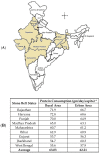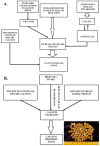The Demographic Diversity of Food Intake and Prevalence of Kidney Stone Diseases in the Indian Continent
- PMID: 30669549
- PMCID: PMC6352122
- DOI: 10.3390/foods8010037
The Demographic Diversity of Food Intake and Prevalence of Kidney Stone Diseases in the Indian Continent
Abstract
Food intake plays a pivotal role in human growth, constituting 45% of the global economy and wellbeing in general. The consumption of a balanced diet is essential for overall good health, and a lack of equilibrium can lead to malnutrition, prenatal death, obesity, osteoporosis and bone fractures, coronary heart diseases (CHD), idiopathic hypercalciuria, diabetes, and many other conditions. CHD, osteoporosis, malnutrition, and obesity are extensively discussed in the literature, although there are fragmented findings in the realm of kidney stone diseases (KSD) and their correlation with food intake. KSD associated with hematuria and renal failure poses an increasing threat to healthcare infrastructures and the global economy, and its emergence in the Indian population is being linked to multi-factorial urological disorder resulting from several factors. In this realm, epidemiological, biochemical, and macroeconomic situations have been the focus of research, even though food intake is also of paramount importance. Hence, in this article, we review the corollary associations with the consumption of diverse foods and the role that these play in KSD in an Indian context.
Keywords: food diversity; food intake; kidney stone disease; social epidemiology.
Conflict of interest statement
Authors declare that no conflict of interest existed while this manuscript was produced.
Figures






References
-
- Hesse A., Siener R., Heynck H., Jahnen A. The influence of dietary factors on the risk of urinary stone formation. Scanning Microsc. 1993;7:1119–1127. - PubMed
-
- Sánchez-Martín F.M., Millán Rodríguez F., Esquena Fernández S., Segarra Tomás J., Rousaud Barón F., Martínez-Rodríguez R., Villavicencio Mavrich H. Incidence and prevalence of published studies about urolithiasis in Spain: A review. Actas Urol. Esp. 2007;31:511–520. doi: 10.1016/S0210-4806(07)73675-6. - DOI - PubMed
Publication types
LinkOut - more resources
Full Text Sources

